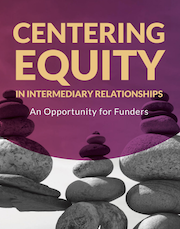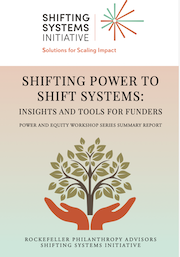Site Search
- resource provided by the Forum Network Knowledgebase.
Search Tip: Search with " " to find exact matches.
CNJG COVID-19 Liability Waiver for in-person events.

Times of mass mobilization like the uprisings for Black lives and global crises like the COVID pandemic broaden awareness of the work of organizations, collectives, and other groups of people working to transform harmful systems. Some of these groups turn to intermediaries—fiscal sponsors and donor intermediaries—to provide back-office support, grant funding, and other services to support their ongoing work and evolution.
This report explores the ways in which the ecosystem of funders and intermediaries can better support these groups—which we’re calling “constituent-led groups”—who do their work without formal 501c3 status and are often led by and supporting historically oppressed communities.
Today, many constituent-led groups, particularly those that are smaller and geographically isolated, struggle to find fiscal sponsors and other intermediaries that share their values and can provide services that are deeply rooted in racial equity. For a number of reasons, funders—who can’t otherwise support constituent-led groups—often prioritize partnering with intermediaries with a high capacity for scaling services and distributing resources and funds. Though equity values are important to funders in selecting intermediaries to partner with, many funders don’t know what equity-centered services look like or how to support intermediaries in deepening this work.
In this report, we share different ways fiscal sponsors and donor intermediaries have approached deepening equity in their work while meeting the volume of demand from constituent-led groups and funders. We also offer some pathways forward for funders seeking to strategically invest in intermediaries to strengthen their capacity in these areas so they might better serve constituent-led groups.
Media Impact Funders partnered with Harvard University’s Shorenstein Center on Media, Politics and Public Policy to produce this case study report that surfaces pioneering funding practices in journalism.
As the field of journalism continues to grapple with limited resources and dwindling revenues, it’s clear that financial support is needed now more than ever. Philanthropy, in response to the radically changing landscape, is stepping up to revive quality journalism and reconfigure the news media ecosystem. And, in fact, funding for nonprofit news media has seen a notable uptick in philanthropic support, oftentimes in the form of new types of grants.
Key takeaways from the case studies include:
- The Einhorn Family Charitable Trust, a foundation that doesn’t have a history of journalism funding, made a four-year investment to help launch the Solutions Journalism Network (SJN).
- The LOR Foundation, fearing residents in the Intermountain West did not have access to quality news, decided to partner with SJN on the local level to produce solutions-based news for the region.
- The Ford Foundation supported the hiring of an investigative reporter at the ACLU of Michigan—the first investigative reporter of any ACLU chapter—to dig into the water crisis in Flint, Michigan.
- The California Endowment invested in youth media hubs as a means to promote community health, well-being and empowerment.
- The MacArthur Foundation made a pioneering unrestricted, five-year grant to the Pulitzer Center on Crisis Reporting, which helped the nonprofit newsroom experiment and innovate.
Despite a field replete with research, analysis, recommended policies and practices — not to mention an abundance of educational programs and frameworks for grantmaking to diverse communities — philanthropic leaders have been slow to advance these values in their foundations. Philanthropy Northwest (PNW) wondered: what is getting in the way? Why are good intentions, buttressed with theory and practical advice, not achieving better results on measures of diversity, equity and inclusion?
With the support of the D5 Coalition, PNW began a year-long study to explore these questions. The study was divided into two parts. They began with personal interviews of 23 philanthropic leaders in the Pacific Northwest. In order to better understand how these organizations incorporated diversity, equity, and inclusion into their work and workplaces, they collected baseline information about their staff composition, leadership styles, and organizational practices/policies.
This report details their findings. It includes an in-depth look at the peer cohort model, in which ten foundation leaders met regularly to discuss these issues and support each other in advancing their own leadership. It also includes practical lessons about shifting organizational cultures towards greater diversity, equity and inclusion — lessons drawn directly from the experiences of peer cohort leaders.
PNW presented this work in a webinar hosted by the D5 Coalition. The webinar recording and slides are below.
FAQs for Benefit Survey
What is the New Jersey Foundation Benefits & Salary Summary Report?
Developed exclusively for CNJG members, the New Jersey Foundation Benefits & Salary Summary Report presents comprehensive benefits data specific to New Jersey's grantmaking community, alongside data from the Council on Foundations' annual salary survey. The last report, produced in 2017, can be found on our website.
Given increased scrutiny in the areas of compensation and benefits, the need to benchmark this information within the field has become even more important. The 2020 New Jersey Foundation Benefits & Salary Summary Report will make available critical information needed to determine fair compensation and benefits in the state across multiple organizational levels.
Who is eligible to participate in this survey?
To be eligible to participate in the survey, your organization must have at least one PAID (full-time or part-time) employee. The beginning of the survey will help respondents determine if they are eligible to participate. Even if you are NOT eligible to participate, please complete the first four questions of the survey. You will then be directed to the last page of the survey where you will be asked to submit your data. You do not need to be a CNJG member to participate. If you do participate, but are not a CNJG member, you will receive a copy of the report.
Where do I complete the survey?
The survey may be completed here: https://www.surveymonkey.com/r/2020CNJGBenefitsSurvey.
When does the survey need to be completed?
The deadline for submitting completed surveys is August 10, 2020.
I'm not the right person to complete this survey, can I email it to someone else to complete?
You may forward the email that contains the survey link to someone else in your organization. The recipient will be able to click on the survey link to access the survey.
How long will it take to complete the survey?
It is estimated that entering in the data should take around one hour (not including the time it will take to research your organization’s information). If you offer more benefits, it may take more time; if you offer less, the less time it will take to complete. Logic is built into the online survey, enabling you to skip questions or entire sections depending on what your organization offers. CNJG suggests looking through the questions first (available in PDF form) and compiling your answers to then enter in the data all at once online.
How do I submit our information to the survey?
CNJG developed the survey using SurveyMonkey, so that you may enter all of your data online. The prompts at the bottom of each page guide you as you enter your information.
Can I see all of the questions first?
Yes! The survey in its entirety can be found below. Feel free to use this document to gather your benefits data, and then enter the information all at once online at https://www.surveymonkey.com/r/2020CNJGBenefitsSurvey.
For which year/time period should I provide compensation and benefits data?
The Benefits Survey should be based on benefits data for the 2020 calendar year. Please complete the survey questions by indicating the benefits that your organization is currently offering to employees in 2020.
Help! The way that this question is structured is difficult (or impossible) for me to answer.
We understand organizations provide different kinds of benefits and have developed novel benefit packages. And, often, benefit packages differ within an organization. Please complete the survey questions by indicating the benefits that are offered to the majority of employees in your organization, and please use the comment boxes after some of the questions and at the end of the survey to further explain/clarify your responses. Please also note that, while many questions are required (indicated with an asterisk) some questions in the survey are optional and can be skipped.
Once I've started the survey, can I save it and complete it another time?
Yes! You may leave the survey at any time by clicking on "Exit this survey" on the upper right hand corner of the page. Note: if you have just entered a page of data, proceed to the next page before you exit, otherwise the data just entered for the current page will not be saved. To reopen the survey, click on the link in the survey email that was sent to you.
Once I've completed the survey, how do I submit my input?
To submit your input, go to the last page of the survey and click on "Submit Survey." Your input will automatically be submitted.
I clicked on "Submit Survey," but I wasn't finished completing the survey - what should I do?
To make changes in a survey that has already been submitted, please contact Craig Weinrich. It will be possible for you to make changes to your survey input until the survey is officially closed on August 10, 2020.
What topics will be covered?
The following topics will be covered in the survey:
• Survey Eligibility
• Organization Information
• Employment
• Leave Benefits
• Insurance Benefits
• Retirement
• Other Benefits
• Retiree Benefits
• Benefits Cost
Who do I contact if I have questions?
Should you have any questions or need additional information, please contact Craig Weinrich.
CNJG thanks you in advance for your time and assistance with this endeavor. The report that we create becomes an important tool for you to benchmark your salaries and benefits plans for the coming years, so the time and effort will be incredibly valuable to your organization and other CNJG members.
Sample conflict of interest policies for Community Foundations.

